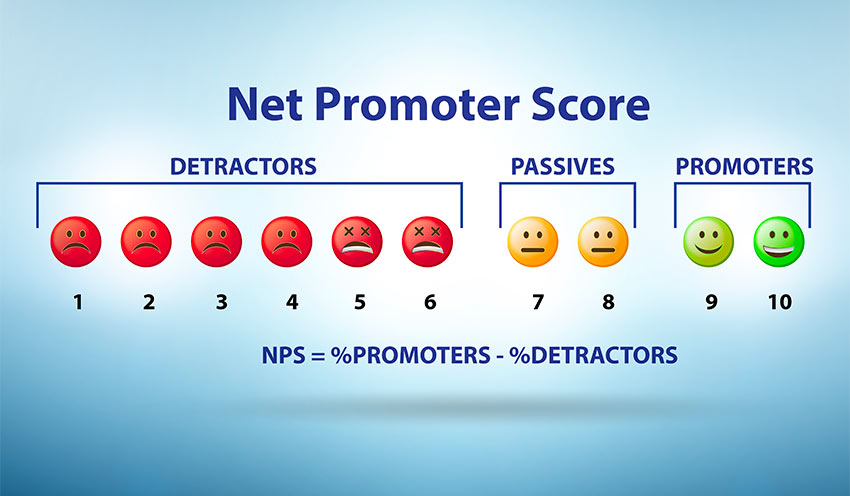The NPS index, acronym for Net Promoter Score, is considered the main metric for measuring customer satisfaction and loyalty worldwide. It is considered a benchmarking tool to evaluate customer satisfaction.
The NPS index asks a single question, namely:
How likely is it that you would recommend this product (this service, this company) to a friend or colleague?
Customers can give a single answer, choosing between a score between 1 and 10.
NPS differs from other benchmarking tools in that it measures the general customer sentiment towards a product, service, company and is not related to a shopping or other interaction experience but to their experience with the brand .
The question posed by the NPS is not limited to measuring the degree of customer satisfaction but is formulated to evaluate the intention of a customer to recommend a product, a service, a company to others.
This question is considered a final question (Americans call it the “ultimate question”) because it tries to figure out how many users are supporters, neutral or critical. Due to this ability to count the people who generate a positive, neutral or negative word of mouth, the index is important for the predictive analysis of the company’s performance.
The consulting firm Bain & Company links the NPS index to the degree of success of a company, highlighting how the top companies are those with the highest NPS index .
The steps required to measure NPS are:
- Prepare a survey
- Collect feedback
- Calculate the index
Prepare the survey
The NPS is based on a single question that emphasizes the intention to recommend a product, service, or company itself to a loved one. It must be expressed as:
How likely is it that you would recommend our service to a friend or relative?
Collect feedback
The answer is a number ranging from 1 to 10.
The answers from 1 to 6 express a criticality on the part of the user, who is considered critical towards the company and therefore generates a negative word of mouth. Users who provide an answer between 1 and 6 are called “Detractors”.
Answers 7 to 8 are considered neutral. People who have provided such answers will tend not to generate word of mouth. Users who provide an answer between 7 and 8 are called “Passives”.
The answers from 9 to 10 express great satisfaction from the user, who is defined as a supporter of the company, capable of generating a positive word of mouth. Users who provide an answer between 9 and 10 are called “Promoters”.
Calculate the index
The index is generated as the difference between the percentage of positive and negative responses obtained on the total number of responses collected.
Therefore, the percentage of neutral responses received is not taken into account.
So the formula is:
NPS = (% Promoters -% Detractors) x 100
Calculation example
Suppose an insurance company administered a survey in which it asked:
“How likely would you be to recommend our consultancy service to a friend or acquaintance?”
Let’s assume he got the following results
| 1 | 2 | 3 | 4 | 5 | 6 | 7 | 8 | 9 | 10 |
| 2 | 3 | 2 | 5 | 4 | 10 | 8 | 9 | 8 | 10 |
| Detractors | Neutral | Supporters | |||||||
| 26 | 17 | 18 | |||||||
| 42% | 29% | ||||||||
| NPS = -13 | |||||||||
The score is therefore between -100 and +100. The worst possible score, i.e. -100, is obtained with a percentage of detractors equal to 100, the best possible one, i.e. +100, with a percentage of supporters equal to 100.
Meaning of Promoters, Passives and Detractors
As we have seen before, depending on the response given by the customer, we can distinguish him into one of three categories (Promoter, Passive and Detractor). Let’s see what they mean.
Promoter
The initiator is a person who replied indicating a value of 9 or 10. It is thought that its actions tend to generate value, not only in terms of future purchases but also with positive word of mouth and therefore act as a promoter of the brand. in technical terms, it is said to have a high “lifetime value”.
Passive
The passive is a person who answered by indicating a value of 7 or 8. His attitude towards the brand is thought to be neutral and therefore his actions bring neither benefit nor harm.
Detractor
The detractor is a person who replied indicating a value between 1 and 6. It is believed that his actions tend to devalue the brand as he will speak negatively about it, i.e. it is believed that his behavior is active and negative and that therefore through reviews, word of mouth, social media he will express his disappointment and damage the reputation of the brand.
The NPS is very popular in Anglo-Saxon countries to evaluate the future trend of a brand.
Advantages of NPS
BENEFITS FOR THE USER
- Very short time required to answer the survey
- Simple question to understand.
BENEFITS FOR THE COMPANY
- Ability to easily assess customer loyalty
- Possibility of performing predictive analyzes on company turnover
- In many sectors, the possibility of making comparisons between your own performance and that of your competitors
- Possibility to act with corrective actions
- Inexpensiveness of the tool
Been to Kiosk Emoticon?
Find out how it can help you measure and know the satisfaction of your customers in a few moments.



